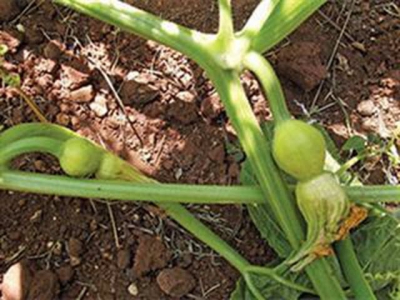Get the spacing right with these veggies

When planting any pumpkin, marrow, gem or other Cucurbitaceae, it’s important to get the spacing right. Get it wrong, and you could lose 50% or more of your yield.
Fruits will abort and turn yellow because the plant has decided that it can only support the fruit already formed. Photo: Bill Kerr
This was brought home to me when growing pumpkins many years ago and I started experimenting with spacing in order to make cultivation easier between the rows. To my surprise, instead of the decreased yield I’d expected, I actually had a better yield with wider spacing. But what really brought matters to a head was the introduction of the first hybrid pumpkins. This forced a re-think of spacing as the recommended planting rates at the time meant it would be too expensive to use hybrid seed.
Two or more
At the time, Boer pumpkins dominated the market and some companies recommended planting up to 6kg/ ha. I was later able to show that 0,5kg/ ha could be planted, with excellent results. What puzzled me was that Boer pumpkin yields were expected to be 20t/ha to 25t/ ha. The department of agriculture’s recommended spacing was 2,5kg/ ha to 3,5kg/ha. As the seed count was about 3 500 seeds/kg, if we planted 3kg/ha, we’d be using 10 500 seeds. Since Boer pumpkins are about 5kg each, 25t would amount to 5 000 pumpkins – a very good yield.
It also meant we were expected to plant two seeds for each pumpkin! Anyone who has ever planted pumpkins knows that you can get two or more from each plant, and more than 10 have been recorded when spacing and conditions allowed for this. I suspect that because the seed was very cheap at the time, it was thought planting extra would ensure we had the foundation to get maximum yield.
In fact, the opposite was true. This was due to survival mechanisms in the Cucurbitaceae genes which helped with their survival before domestication. When a pumpkin starts off, it produces runners from the crown, and other runners develop from these. The first female fruit will develop some distance from the crown. In the case of Boer pumpkins, this was usually about 1,5m in summer.
By this time, the pumpkin would have covered a lot of area and would have enough leaf area utilising sunlight to start filling out fruit. If, at this time, runners from other plants met up with the runners from this plant, the plant would start to abort subsequent fruit. These would turn yellow and eventually rot. Speculation at the time was that this was a pollination issue, which is certainly not the case.
Real reason
The real reason for aborting fruit goes back a long way to when plants competed with one another in the wild. Plants which set all fruit when in competition with other plants, would, by being shaded out by competition, eventually not have the resources to fill out all the fruit to seed maturity and thus not be able to ‘transfer’ their genes to the next generation.
Plants that survived were those who placed priority on ensuring that there were enough healthy leaves to bring fruit to maturity. In this respect, the plants were conservative. We then wonder why, when we have applied an abundance of fertiliser and ensured enough water, that we don’t get a good crop. Farmers often tend to estimate yield by the fact that they have a waist-high stand of pumpkins covering every centimetre of ground and expect a yield commensurate with the leaf volume.
The pumpkins’ safety precautions have caused this problem. We have to understand the pumpkins’ way of thinking if we’re to get top yields. On one occasion, I shared this concept with a pumpkin farmer. For a moment I thought I’d lost him. But I was wrong. He was from a warm area where they traditionally plant only in the cooler months, and lose yield when they plant after August.
He said that one year, after planting fruit trees, they planted a single row between the rows of fruit trees. This was after August and they expected a poor yield, but got a bumper crop. The wider spacing prevented abortion of fruit and suddenly he understood the concept.
Related news
 Hi-tech agricultural fair highlights Mekong Delta farm produce
Hi-tech agricultural fair highlights Mekong Delta farm produce A trade fair featuring hi-tech agriculture and safe farm produce from the Mekong Delta region opened in Rach Gia city, in the Mekong Delta province of Kien Gian
 Dau Tieng: Effective urban agricultural models promoted
Dau Tieng: Effective urban agricultural models promoted In the face of the situation plus the support of the State, the local farmers have flexibly applied urban agricultural models.
 Longan and lychee season experiences record revenue
Longan and lychee season experiences record revenue Thanks to favorable weather conditions and effective advertisement, several northern localities enjoyed successful 2018 longan and lychee seasons.